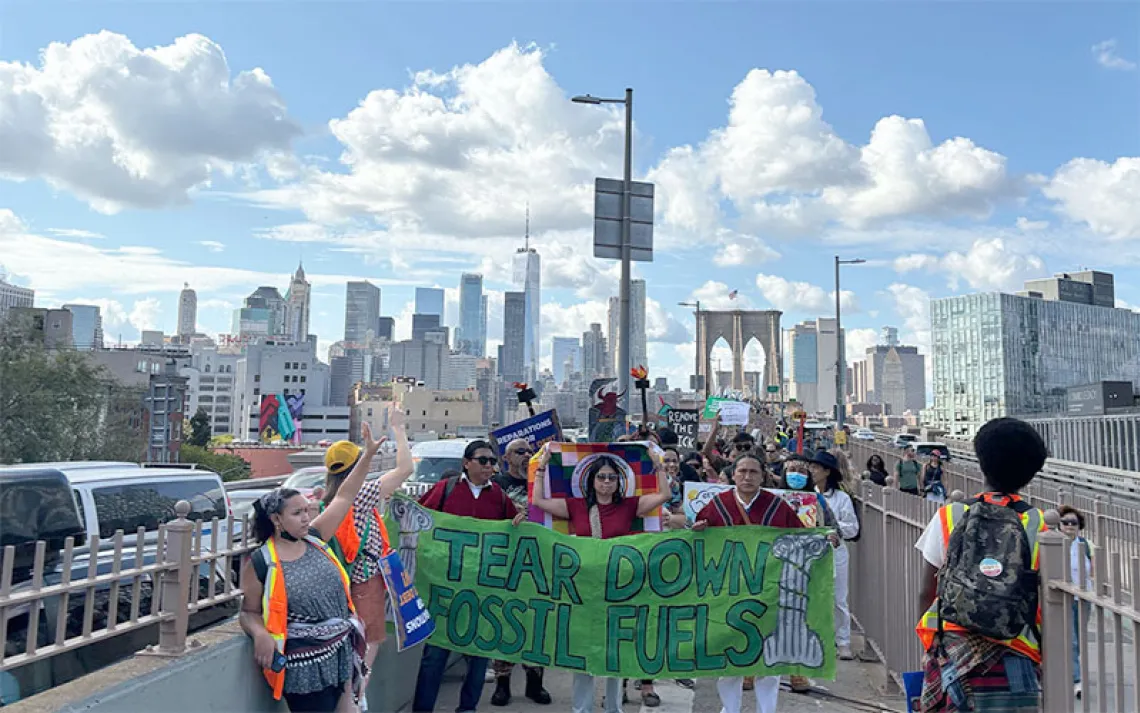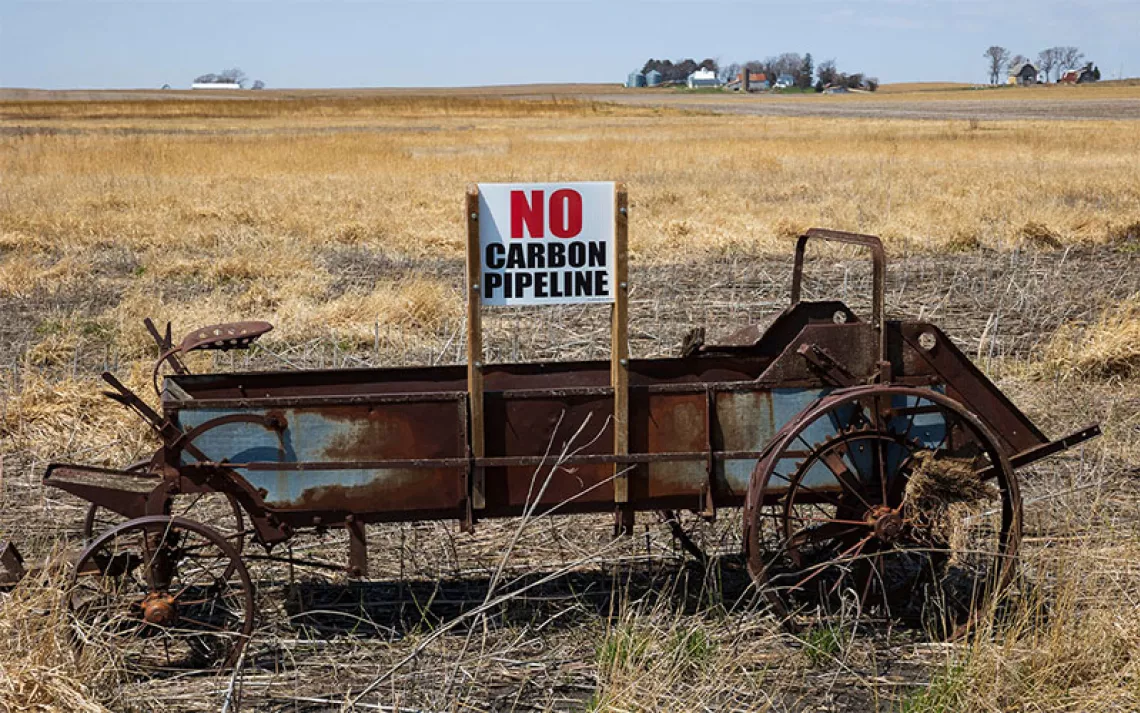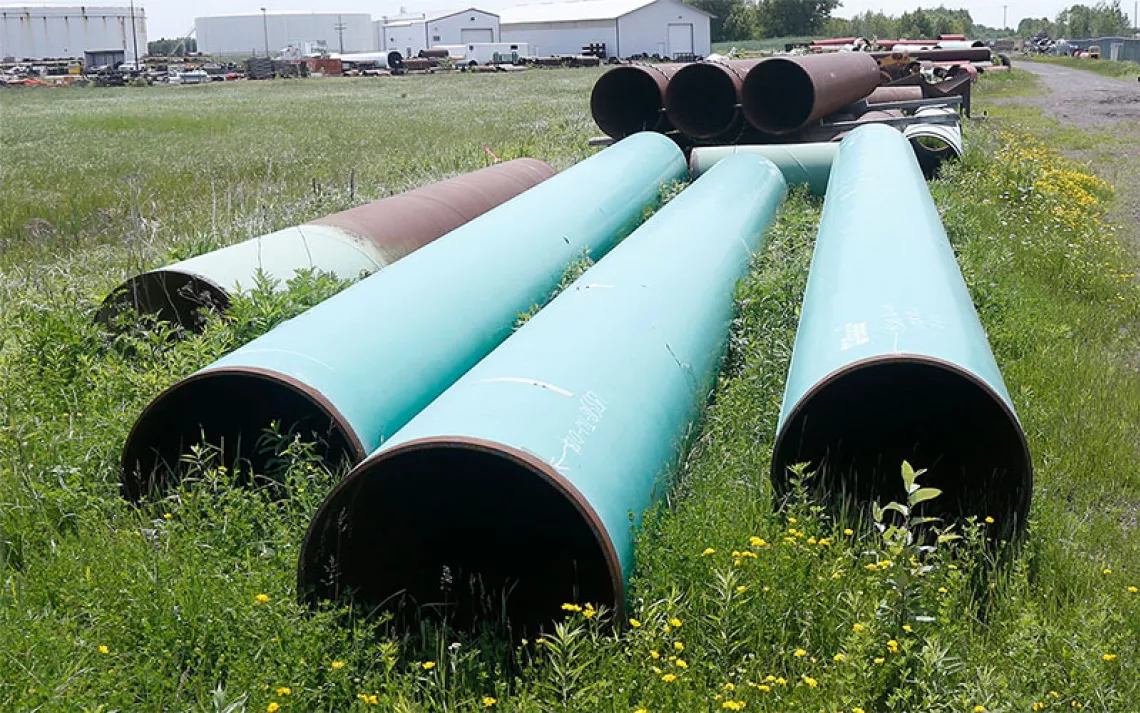Water Protectors Intensify Campaign to Shut Down Line 3 Oil Pipeline
At least 100 people arrested in northern Minnesota

Hubbard County, Minnesota. Law enforcement agents form a line in front of a wall of protesters sitting in front of a locked gate at an Enbridge pump station on Monday, June 7. | Photo by Alex Kormann/Star Tribune via AP Photos
Gina Peltier says she has had enough. A member of the Turtle Mountain Band of Chippewa, Peltier is one of the more than 1,000 Indigenous water protectors and climate activists who have converged on northern Minnesota as part of the escalating effort to halt construction on Enbridge’s Line 3 oil pipeline. Early Monday morning, she stood on a gravel road near the banks of the Mississippi River as she and others prepared to engage in civil disobedience to stop the pipeline. “This is a straight-up war on our water,” said Peltier, whose gentle demeanor belies her unflinching fierceness. “They legitimately want to make money on the scarcity of water.”
Since the nearly $3 billion project was first proposed in 2014, Anishinaabe tribes and allies have been leading resistance against the project, which they say violates Native American treaty rights, jeopardizes the area’s natural resources, and will inevitably fuel global climate change. A Minnesota agency granted the final permits for construction last November, spurring Indigenous water protectors—spearheaded by the Giniw Collective—to repeatedly occupy construction zones to protest the project.
Now, pipeline resisters are intensifying their opposition. In the last week, Indigenous activists and environmentalists from across the country have gathered in remote northern Minnesota as part of the Treaty People Gathering. They hope their civil disobedience will spur the Biden administration to shut down pipeline construction.
“We have written our letters, we have made the phone calls, and they’re ignoring us,” Peltier told Sierra. “Millions of people’s lives are at stake, and their livelihoods are threatened—all for the sake of a Canadian corporation making money off of selling oil to China.”
Led by well-known Indigenous activists such as Winona LaDuke, Dawn Goodwin, and Tara Houska—and joined by celebrities including Jane Fonda and author-activist Bill McKibben—the water protectors on Monday occupied a section of the Mississippi River where the pipeline is slated to cross, as well as a pumping station critical for construction, before setting up a camp within the construction zone. So far, nearly 200 people have been arrested with dozens more cited, according to Treaty People Gathering organizers.
Designed to transport hundreds of thousands of barrels of tar sands oil from Canada to the United States daily, the expanded Line 3 will intersect with more than 200 bodies of water, slicing through sacred wild rice lakes and fragile watershed ecosystems as it traverses the portions of the White Earth Nation and other the Anishinaabe treaty lands. After a suspension of construction during court appeals and a brief halt this spring, the pipeline’s more than 4,000-person construction workforce resumed operations June 1.
At daybreak on Monday, with temperatures already climbing past 90 amid a record-setting heat wave, hundreds of activists arrived at the Two Inlets Line 3 pump station. Some people locked themselves to heavy equipment, while others sought to form a protective cordon around those risking arrest.
“Our Mother is calling out. It’s time for us to listen or do the work to remember how. It’s also time for us to all stand with our words,” said Tara Houska of the Giniw Collective, an Indigenous, women-led resistance group that initiated the Treaty People Gathering. “The situation is urgent; it requires an urgent response.”
About a half mile up the road, a sunhat-clad and sunscreen-slathered crowd of at least 1,000 people began to coalesce, joining the RISE Coalition—another activist group led by Indigenous women—to march toward the headwaters of the Mississippi River. Bill McKibben was among them. “Let’s say nothing ever, ever spilled out of the pipeline,” he told Sierra. “Once what’s in it gets burned, it’s all going to spill into the atmosphere, and that’s what’s heating up the planet.”
More cars arrived and dropped off scores of other protesters, most of them holding signs that simply and clearly declared, “Stop Line 3” and carrying backpacks filled with water and snacks. The crowd gathered behind the Indigenous leaders and then started to march along the highway, the tar strips of the roadway soft and slippery in the intense June heat.
Near the front of the column, Lou Montelongo, a 21-year-old Cherokee woman, stood with her corgi-French bulldog mix by her side. She and a handful of friends came from North Carolina to gather with other treaty people and allies “to protect our water and Mother Earth.”
“I want people to know that we’re still here,” she said. “No matter what we went through—forced genocide, forced assimilation—we’re still here. And we’re going to be here for seven generations to come after us.”
Jane Fonda was also in the crowd, dressed in all-black and holding a sign printed with Biden’s face and asking “which side” he’s on. “We face such a terrible crisis that will determine whether or not there’s a future,” said Fonda, who was engaging in her second protest against Line 3. “The reason we’re all gathered today is because we want them to know this. He [President Biden] could stop this. He could ask the Army Corps of Engineers to pull the permit,” she said, gesturing to her Biden sign. Ultimately, “we want to Standing Rock this place,” she concluded, referring to the historic 2016 protests against the Dakota Access Pipeline.
So far, the Biden administration has made no indication that it will use federal authority to halt Line 3.
As the march began, Winona LaDuke and other Indigenous leaders guided the way with drums and chants, eventually stopping near a wooden bridge over the Mississippi River. Under canvas tents, an Anishinaabe water ceremony was held in preparation of the overnight occupation that would follow. Dragonflies buzzed overhead as a handful of people began blazing a trail through the wetlands that flank the highway. Sinking into cool, brown water between clumps of muddy grass, roughly 150 water protectors trekked toward a nearby wooden boardwalk where the pipeline is slated to cross the river and started to set up a tent camp to occupy the space.
As water protectors hopped off the boardwalk and joyfully waded into the Mississippi to cool off amid the heat, Nancy Beaulieu addressed the larger crowd that remained on the nearby bridge.
“We’re going to remind Enbridge, [Minnesota] Governor Waltz, Biden that they must honor the treaties and live in peace and protect the earth as those treaties intended,” Beaulieu, a member of the Minnesota Chippewa Tribe, declared to claps and cheers. “This is the beginning of the future that we’re going to build together.… We’re going to do it for our relatives who swim in the water, that fly in the sky. We’re going to do it for each other. We’re going to do it for the seventh generation.”
Contemplatively pacing the boardwalk was Reverend Fred Small, a Unitarian Universalist minister from Cambridge, Massachusetts, who has long been active in climate action advocacy. When asked what brought him all the way to rural Minnesota, Small responded, “I’m the descendant of colonizers going back to the Mayflower, so my people … stole this land from its inhabitants and they rationalized it by faith and reason, but it was distortion. So, it’s my job to make amends for what my people have done and also for the privilege and benefits that I receive.” Small continued, “Climate change itself is theft, theft from future generations and the most vulnerable people on the planet. Every religious tradition forbids theft. Every religious tradition calls us to care for creation.”
As the boardwalk occupiers were setting up their tents and passing out water, sunscreen, and dried mango, the Two Inlets occupation farther down the road had relaxed into a similarly tranquil mood—though many people were shaken and angry after a morning that consisted of a Border Patrol helicopter kicking up dust in an effort to clear out the activists.
Past several barricades—one composed of a boat, another of blue mesh tubes that had been coiled up to form a snake complete with wide eyes and a red tongue—people were distributing water to those locked to the machinery. Others rested in whatever shade they could find along the gravel road that led to the pump station and chatted over Gatorade and hand-rolled cigarettes. “Land Back” was scribbled across a wall in beige masking tape. A banner with the slogan “Stop Line 3” swayed from the top of the silent backhoes.
By the afternoon, the celebratory atmosphere of the morning had changed with the appearance of law enforcement. Face-shield-clad Minnesota State Patrol and local police officers equipped with riot gear descended on the station as chants to “Stop Line 3” rang out.
Law enforcement soon began making arrests, separating protesters who had linked arms along the entrance to the station, zip-tying their hands and leading them away before closing in on the pump station itself. By 10:30 P.M. on Monday, more than 100 people had been arrested as police, working by vehicle headlights, dismantled the lockboxes that protesters had used to chain themselves to the equipment. Meanwhile, the dozens of people camped on the boardwalk had settled in peacefully for the night.
The long day of civil disobedience in defense of water and a livable climate had, for the most part, been as jubilant and as defiant as Gina Peltier had wished at daybreak. “I’m really hoping for peace and everyone’s safety,” she had said then. “I hope people will spread the awareness. That’s why we’re here.”
 The Magazine of The Sierra Club
The Magazine of The Sierra Club



